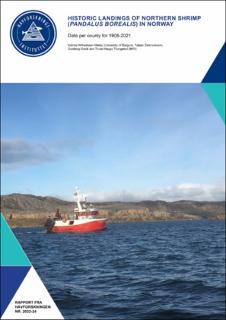| dc.contributor.author | Melaa, Katrine Wilhelmsen | |
| dc.contributor.author | Zimmermann, Fabian | |
| dc.contributor.author | Søvik, Guldborg | |
| dc.contributor.author | Thangstad, Trude Hauge | |
| dc.date.accessioned | 2022-08-30T10:35:10Z | |
| dc.date.available | 2022-08-30T10:35:10Z | |
| dc.date.created | 2022-08-23T14:10:53Z | |
| dc.date.issued | 2022 | |
| dc.identifier.uri | https://hdl.handle.net/11250/3014329 | |
| dc.description.abstract | Time series of landed catches are often the only data source available that encompasses most or all of a fishery’s history, providing important information for stock assessment and fisheries management. Although landings data were registered in Norway with a spatial resolution of landing county or lower for over a century, most of the data were only published in statistical yearbooks in the past and are therefore not readily available. Here, we digitalized spatially resolved information on shrimp landings and value of landings from 1908 to 1976, and combined them with landings data from 1977 to 2021 to produce a comprehensive overview of the shrimp fishery in Norway since its infancy more than a century ago until today. The resulting time series shows how the shrimp fishery after its beginning in the eastern Skagerrak and Oslofjord region at the turn of the 20th century, expanded west- and northwards along the Norwegian coast over the following decades, developing into a relevant coastal fishery as well as an offshore fishery in the Skagerrak. After World War II had temporarily halted the development of the fishery, it increased with a higher pace due to subsequent progress in industrial fishing and the emergence of offshore fisheries in the Barents Sea and around Svalbard. The latter development caused together with periods of long-distance fishing activities in the Northwest-Atlantic and around Greenland and Jan Mayen substantial increases in shrimp landings from the 1980s onwards. While total annual shrimp landings remained largely on the level of a few thousand tonnes in previous decades, they peaked above 80 000 tonnes in the 1980s and early 2000s. However, throughout the time series and particularly during the latest decades, substantial fluctuations in landings and their spatial distribution have been observed. In absence of catch limits for shrimp outside of the Norwegian Deep and Skagerrak area, the observed changes in the landings have mostly been driven by technological progress and economic factors, notably prices. However, masked by the large landings from the offshore segments of the fishery, the data also show a decline of shrimp landings in West- and Mid-Norway, indicating a disappearance of the shrimp fishery and possibly also the shrimp stock in these areas. The results underline the relevance of spatially resolved landings and value data for our understanding of the development of a fishery across its history, and thus the importance of making such data readily available to research and fisheries management. | |
| dc.description.abstract | Historic landings of northern shrimp (Pandalus borealis) in Norway - Data per county for 1908-2021 | |
| dc.language.iso | eng | en_US |
| dc.publisher | Havforskningsinstituttet | en_US |
| dc.relation.ispartof | Rapport fra havforskningen | |
| dc.relation.ispartofseries | Rapport fra havforskningen;2022 - 24 | |
| dc.relation.uri | https://www.hi.no/hi/nettrapporter/rapport-fra-havforskningen-en-2022-24 | |
| dc.title | Historic landings of northern shrimp (Pandalus borealis) in Norway - Data per county for 1908-2021 | en_US |
| dc.title.alternative | Historic landings of northern shrimp (Pandalus borealis) in Norway - Data per county for 1908-2021 | en_US |
| dc.type | Research report | en_US |
| dc.description.version | publishedVersion | |
| dc.source.pagenumber | 31 | en_US |
| dc.source.issue | 2022 - 24 | en_US |
| dc.identifier.cristin | 2045407 | |
| dc.relation.project | Havforskningsinstituttet: 14919 | |
| dc.relation.project | Havforskningsinstituttet: 15619-03 | |
| cristin.ispublished | true | |
| cristin.fulltext | original | |
